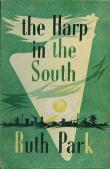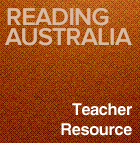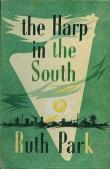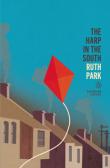
 3392728731927471268.jpg
3392728731927471268.jpg
Latest Issues
AbstractHistoryArchive Description
'Amid the brothels, grog shops and run-down boarding houses of inner-city Surry Hills, money is scarce and life is not easy. Crammed together within the thin walls of Twelve-and-a-Half Plymouth Street are the Darcy family: Mumma, loving and softhearted; Hughie, her drunken husband; pipe-smoking Grandma; Roie, suffering torments over her bitter-sweet first love; while her younger sister Dolour learns about life the hard way.' (Book description from publisher's website.)
Adaptations
-
y
 The Harp in the South
1949
(Manuscript version)x400878
Z286009
1949
single work
drama
The Harp in the South
1949
(Manuscript version)x400878
Z286009
1949
single work
drama
-
form
y
 The Harp in the South
( dir. Alan Burke
)
United Kingdom (UK)
:
British Broadcasting Corporation (BBC)
,
1964
8144099
1964
single work
film/TV
The Harp in the South
( dir. Alan Burke
)
United Kingdom (UK)
:
British Broadcasting Corporation (BBC)
,
1964
8144099
1964
single work
film/TV
A BBC television adaptation of Ruth Park's novel.
-
form
y
 The Harp in the South
Ruth Park's The Harp in the South
( dir. George Whaley
)
1987
Sydney
Australia
:
Anthony Buckley Productions
Network Ten
,
1987
Z993016
1987
series - publisher
film/TV
The Harp in the South
Ruth Park's The Harp in the South
( dir. George Whaley
)
1987
Sydney
Australia
:
Anthony Buckley Productions
Network Ten
,
1987
Z993016
1987
series - publisher
film/TV
Adapted from Ruth Park's novel of the same name, The Harp in the South is a six-part mini-series that follows the lives of an impoverished Irish-Australian family during the late 1940s. The Darcy family have moved from the bush to a housing-commission enclave in inner-city Sydney: a world of sly grog shops, prostitutes, pimps, and boarding houses. The father, Hughie, was a shearer's cook who lost his job through alcoholism. Although he is now able to hold down a job, his pay is often docked because he's recovering from a hangover. The family is held together by Mumma Darcy, a kindly but uneducated woman who still cannot get over the loss of her son, who disappeared as a child many years ago. The Darcys' two remaining children are Dolour (who is still at school) and Rowena (who works in a local factory). In order to make ends meet, the family take in boarders, some of whom are quite strange.
-
y
 The Harp in the South Trilogy : The Play : Parts One and Two
Strawberry Hills
:
Currency Press
,
2018
11940858
2018
single work
drama
The Harp in the South Trilogy : The Play : Parts One and Two
Strawberry Hills
:
Currency Press
,
2018
11940858
2018
single work
drama
'A great Australian novel. A landmark theatre event. A portrait of Sydney as it once was.
'The world premieres of The Harp in the South: Part One and The Harp in the South: Part Two are designed to be enjoyed as one unforgettable, epic theatrical experience.
'This major new work is one of the most ambitious productions STC has ever created. Celebrated playwright Kate Mulvany has adapted novelist Ruth Park’s revered Australian trilogy – Missus, The Harp in the South and Poor Man’s Orange – and spread these beloved stories across two equally ambitious plays.
'The two parts stand alone, but together they offer over five hours of monumental, exuberant theatre. It’s a moving family saga and a celebration of Sydney in all its funny, gritty glory.'
Source: Publisher's blurb.
Reading Australia
This work has Reading Australia teaching resources.
Unit Suitable For
AC: Year 11 (Unit 2)
Themes
ageing, Australian humour, coming of age, domestic life, life and death, love, poverty, resilience, romance, the Depression, the past
General Capabilities
Critical and creative thinking, Ethical understanding, Information and communication technology, Literacy, Personal and social
Cross-curriculum Priorities
Aboriginal and Torres Strait Islander histories and cultures
Notes
-
Ranked #4 in ABC1's First Tuesday Book Club '10 Aussie Books to Read Before You Die' 2012 voting ballot.
-
Dedication: To my father who first told me stories and my mother who first encouraged me to write them.
Publication Details of Only Known VersionEarliest 2 Known Versions of
Other Formats
- Braille.
- Sound recording.
- Large print.
Works about this Work
-
Ruth Park’s Charlie Rothe : Reading Harp in the South (1948) and Poor Man’s Orange (1949)
2023
single work
criticism
— Appears in: Australian Literary Studies , 19 December vol. 38 no. 3 2023;'Ruth Park’s novels The Harp in the South (1948) and Poor Man’s Orange (1949) portray a fictional Irish-Australian family living in the actual inner-city neighbourhood of Surry Hills. The poor, immigrant status of the Darcys is foregrounded in the novels from the start, yet equally important is the character of Aboriginal man Charlie Rothe, who is introduced in Chapter 14 of The Harp in the South. This essay suggests that Charlie’s late arrival is the reverse of the non-fictional situation evoked in the opening of Park’s The Companion Guide to Sydney (1973), in which the author imagines the First Fleet’s entry into a place that was already occupied. The issue of ‘first-ness’, and what comes after, is central to Park’s narration of both family intimacy and romantic love between her Irish Australians and latecomer Charlie. Highlighting enigmatic descriptions of Charlie’s Aboriginal parentage and ancestry and associating this language with the appropriative desire felt by each of the Darcy sisters, I argue that the character of Charlie is pivotal to Park’s exploration of themes of imitation, borrowing, possession and (belated) recognition.' (Publication abstract)
-
Guide to the Classics : Ruth Park’s Harp in the South Is a Story about Aboriginal Country
2023
single work
review
— Appears in: The Conversation , 12 October 2023;
— Review of The Harp in the South 1947 single work novel'Ruth Park’s novel The Harp in the South (1948) is a classic of Australian fiction. Just as television viewers in recent decades would recognise “Ramsay Street” as the fictional centre of Australia’s longest-running television soap opera Neighbours, earlier generations of readers would have recognised with affection “Twelve-and-a-half Plymouth Street”: the hearth and home of Harp’s fictional Irish-Australian family, the Darcys.'
-
Surro
2017
single work
essay
— Appears in: Sydney Review of Books , November 2017;'Head south on Elizabeth Street, turn left after Devonshire. Butt Street is more of an alley, with a slight kink at the beginning. Apartments and warehouses loom either side. You are walking towards Clisdell Street in August 1940, and on the left in the gutter is the corpse of Bill Smillie, gambler, gunman, SP standover. Next to his body is a dead cat.' (Introduction)
-
12 Books Every Australian Should Read
2016
single work
essay
— Appears in: Australian Geographic [Website] , February 2016; 'Take a literary journey to the interior with these 12 must-read Australian books, representing a cross section of Australian literature, meditating on landscape, history and what makes us Australian.' -
Walking the Talk: Fans Honour Park’s Work in Surry Hills
2015
single work
column
— Appears in: The Sydney Morning Herald , 17 April 2015; (p. 17) 'On Saturday [18 April 2015], to honour the author and her work, more than 100 people will join the ‘‘walk and talk’’ Harp in the South Day event, supported by the Irish National Association of Australasia.'
-
Untitled
2004
single work
review
— Appears in: Australian Bookseller & Publisher , June vol. 83 no. 11 2004; (p. 18)
— Review of The Harp in the South 1947 single work novel -
Ruth Park's Vivid World
1992
single work
review
— Appears in: The Canberra Times , 28 March 1992; (p. C8)
— Review of The Harp in the South 1947 single work novel ; Poor Man's Orange 1949 single work novel -
Formula for Success
1948
single work
review
— Appears in: The Australasian Book News and Literary Journal , February vol. 2 no. 8 1948; (p. 404-405. 440)
— Review of The Harp in the South 1947 single work novel -
The Harp in the South
1948
single work
review
— Appears in: The Bulletin , 3 March vol. 69 no. 3551 1948; (p. 2)
— Review of The Harp in the South 1947 single work novel -
The Harp in the Orchestra
1948
single work
review
— Appears in: Southerly , vol. 9 no. 3 1948; (p. 182-184)
— Review of The Harp in the South 1947 single work novel -
y
 The Paradoxical Taboo : White Female Characters and Interracial Relationships in Australian Fiction
Brisbane
:
2004
Z1180791
2004
single work
thesis
The thesis looks at the way white female characters and interracial relationships are represented in Australian fiction by white Australian writers.
The Paradoxical Taboo : White Female Characters and Interracial Relationships in Australian Fiction
Brisbane
:
2004
Z1180791
2004
single work
thesis
The thesis looks at the way white female characters and interracial relationships are represented in Australian fiction by white Australian writers.
-
100 Most Influential Australians : Ruth Park : Writer
2006
single work
column
— Appears in: The Bulletin , 4 July vol. 124 no. 6527 2006; (p. 100) -
Notes and News
1948
single work
column
— Appears in: The Australasian Book News and Literary Journal , February vol. 2 no. 8 1948; (p. 439-440) -
Joy McKean : The Books that Changed Me
2012
single work
column
— Appears in: The Sun-Herald , 5 February 2012; (p. 8) -
Turn Pages of Time for a Great Read
2012
single work
column
— Appears in: The Sun-Herald , 13 May 2012; (p. 21)
Awards
- 2012 shortlisted The National Year of Reading 2012 Our Story Collection — New South Wales
- 1946 winner The Sydney Morning Herald Literary Competition
- Surry Hills, Inner Sydney, Sydney, New South Wales,
- 1940s















